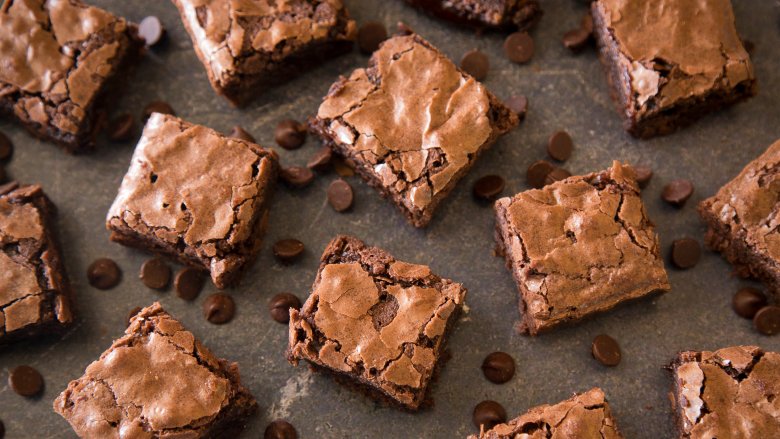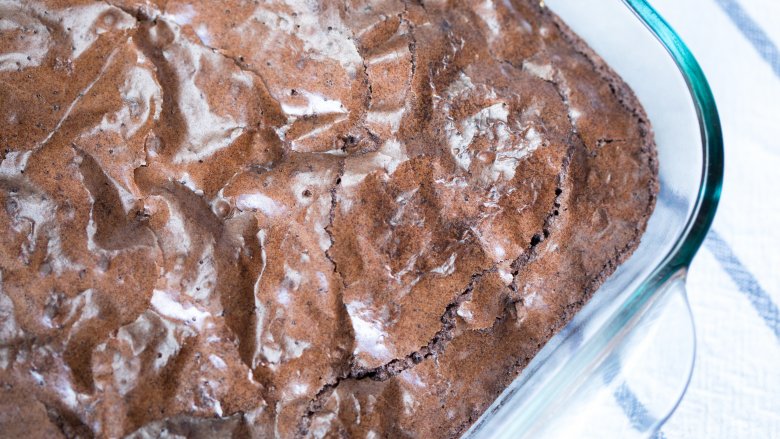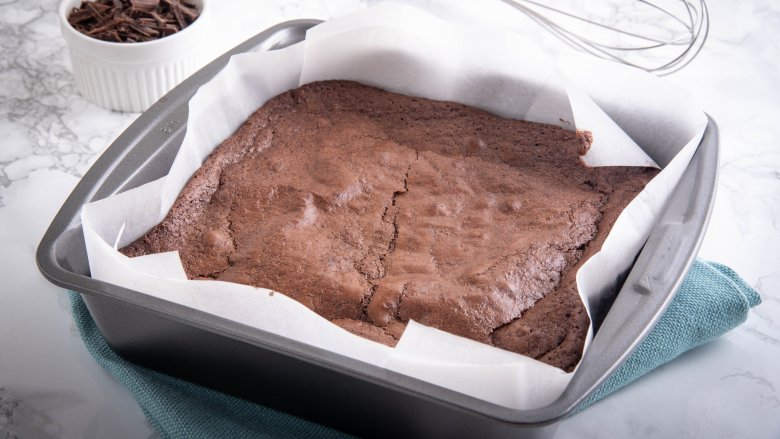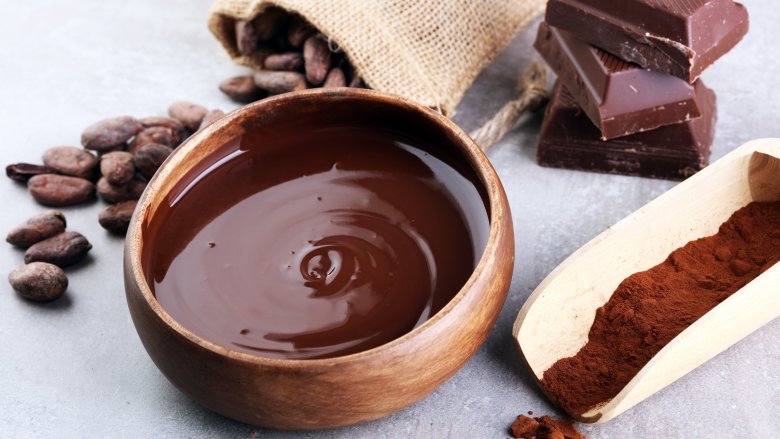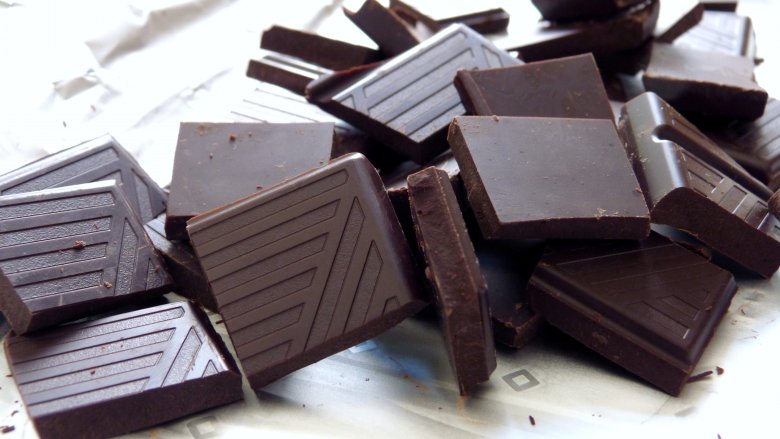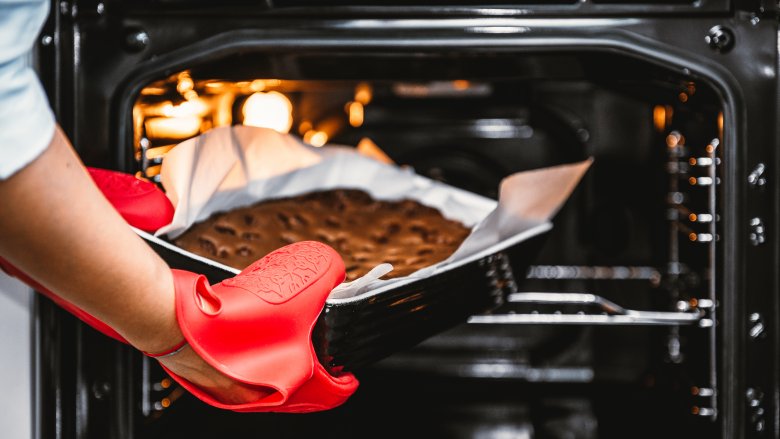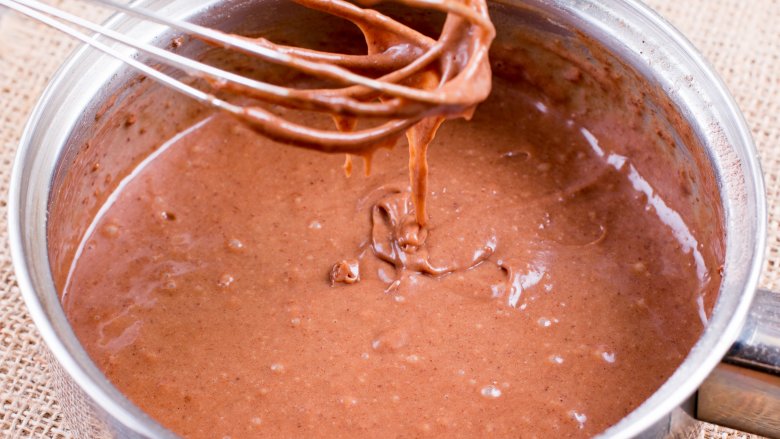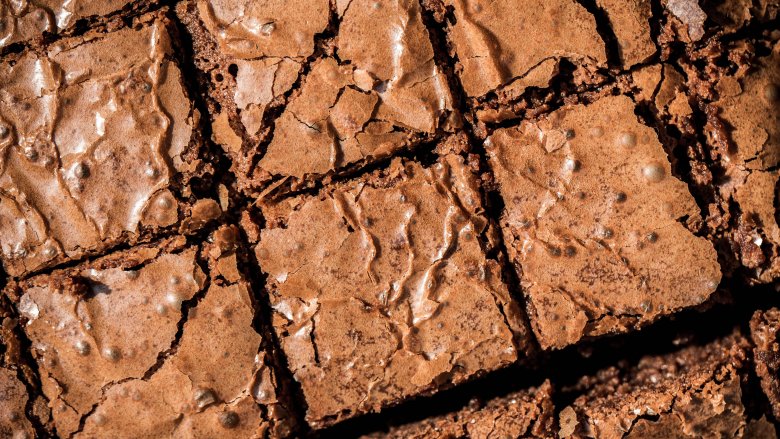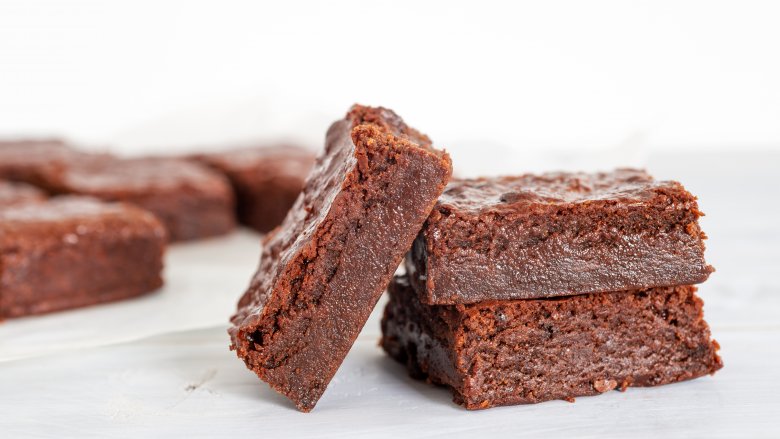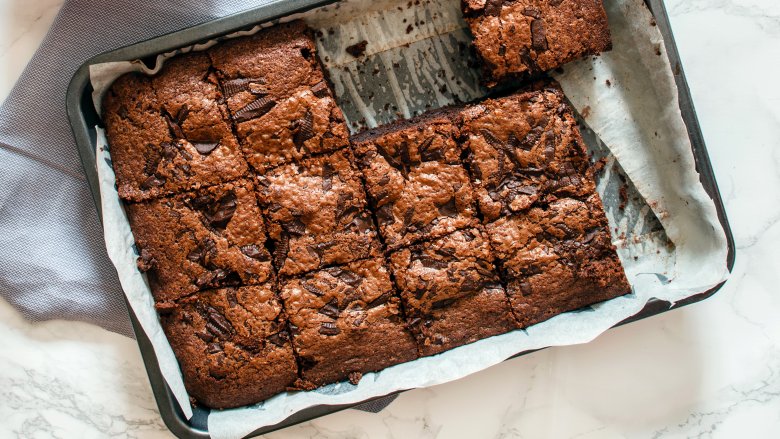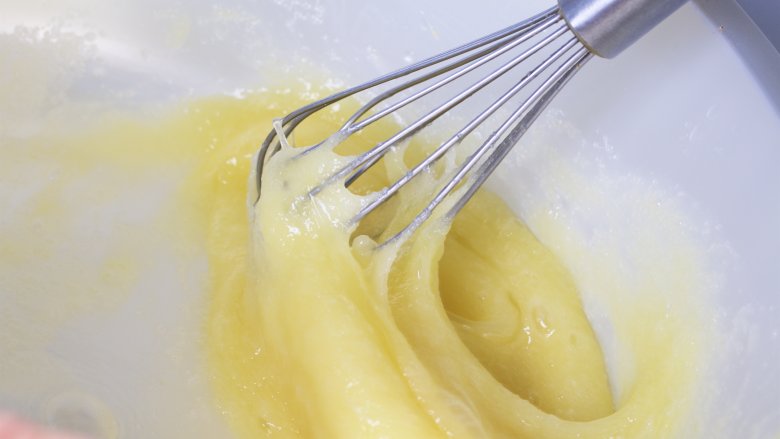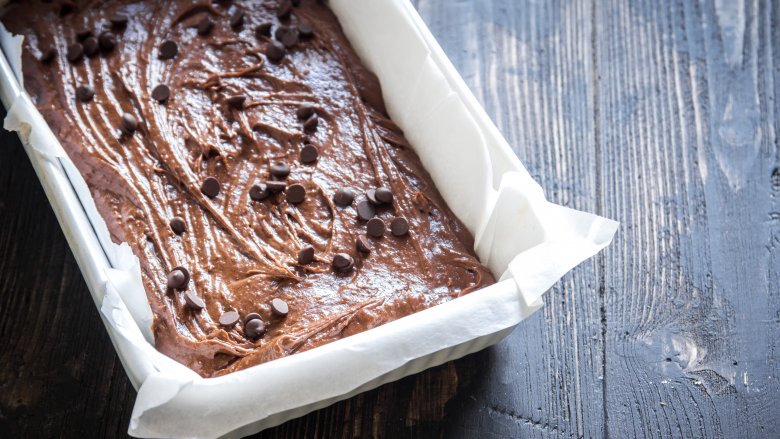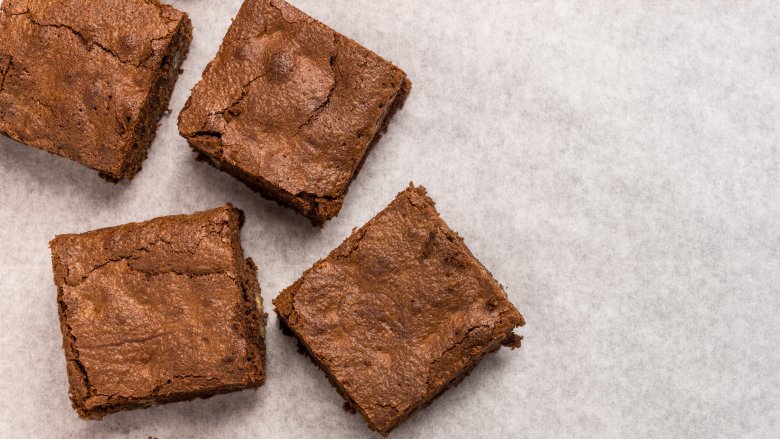The Biggest Mistakes Everyone Makes When Baking Brownies
Is there anything worse than a bad brownie? Whether they're thrown together from a box mix, or whipped up from scratch, you sink your teeth into a warm brownie with the highest of hopes for rich, fudgy goodness. And when it's subpar? That's got to be in the top 10 of culinary disappointments.
There's a lot that can go awry with brownies — they can be too cakey (the world's worst brownie sin), they can have rock-hard edges with an undercooked middle, and they can be lacking that deep chocolaty flavor you crave. The good news is that better brownies are easily attainable, especially if you know what it is you're doing wrong.
Before you mix up one more batch of bad brownies, commit these common baking mistakes to memory, then use the smart tips and tricks we've provided to get on the right track to making the best brownies of your life. And yes, plenty of these techniques apply to boxed brownies, too — because, let's be honest here — it's hard to convince ourselves to bake brownies from scratch when there's a 99-cent, 10-minute version staring us in the face.
You're overbaking (or underbaking)
As with most baked goods, the amount of time brownies spend in the oven can make or break them. And if you're looking for that spectacularly fudgy texture from edge to edge, it can be difficult to know just how long those brownies need to bake. So what's the trick?
According to Epicurious, the tried-and-true method of using a toothpick or a cake tester won't work — that's because properly fudgy brownies are always going to yield a chocolate-coated toothpick when you poke them, and if they don't, you've entered into the dreaded overbaked and cakey territory. Aside from following a trusted recipe to a T — which is even more important with brownies than other treats, it's a good idea to rotate the pan halfway through the cooking time. Since most ovens have hot and cool spots, this ensures that the brownies will bake evenly. Those are the basics, and following those rules will probably afford you fine brownies.
But the real way to tell when your brownies have reached optimal doneness? Check for the crack. Katzie Guy-Hamilton, Global Director of Food and Beverage of chocolate heaven Max Brenner, told Epicurious that once the top is shiny and set (not "wiggly"), the first cracks are a telltale sign that your brownies are ready. In this case, no matter what the timer says, yank those bad boys from the oven. The result should be fudgy and gooey — but not underbaked — perfection.
You're not using parchment paper
Maybe you made an entire batch of brownies for yourself and don't care how easily or not easily they come out because you're going to eat them straight out of the pan with a fork. We salute you... but for those of you who want to share a brownie or two, and also want them to look like they didn't get put through the wood chipper first, you really should think about lining the pan with parchment paper.
It's an extra step, yes, but it ensures that each and every brownie will come out of the pan perfectly — even the dreaded first brownie — with no chance of sticking. Real Simple recommends creating a sling with two strips of parchment by buttering or spraying the pan, and laying one strip into the pan, leaving an overhang on two sides. Butter or spray that strip, then press the second strip in to overhang the two remaining sides. One more coat of butter or spray, and in goes the batter. Once cool, all you need to do is grab the overhanging parchment to use as handles, and voilà — no fuss, no muss, easily cuttable brownies.
You're using chocolate instead of cocoa powder
You might think that ooey gooey melted chocolate would be the superior choice when it comes to brownie baking, but you would be wrong. Cocoa powder actually takes the cake... er, brownie here.
Pastry chef extraordinaire Alice Medrich writes for Food 52, "...brownies made with cocoa can have very deep chocolate flavor and still retain a softer and moister texture than an equally chocolatey brownie made with a bar of chocolate." How can that be? It's all because of the fat. When you use cocoa powder, you have to replace the fat that you would have gotten from the chocolate's cocoa butter with actual butter. The difference in these fats is that butter stays soft at room temperature, while cocoa butter firms up. See where we're going here? Those chocolate brownies — which happen to be chock-full of cocoa butter — might be fine right out of the oven, but once they cool, they can turn dry and hard. The cocoa brownies, on the other hand, remain nice and tender thanks to all that not-firm-at-room-temperature butter.
When it comes to choosing between natural or Dutch-processed cocoa powder, Cook's Illustrated confirms that baked goods made with the more acidic natural cocoa were drier, while those made with the less acidic Dutched were fudgier, and made for an earthier, richer chocolate flavor. Sold.
You're using the wrong chocolate
If you do choose to forgo the cocoa powder and make chocolate brownies instead, you definitely want to be picky about the quality of the ingredient. Now, that doesn't mean splurging for the $20 per ounce artisan chocolate that's been made by unicorns and sprinkled with gold leaf, but you'll want to skip the super-cheap stuff, too. Bon Appétit senior associate editor Claire Saffitz puts it this way: "I wouldn't bake with an $11 artisanal bar," but there is a middle ground. "It should be delicious enough on its own to eat as a snack," she explains.
Now what about chocolate bars versus chocolate chips? Is there really any difference? There is, and it's a big one. While it might be easier to grab the bag of chips rather than painstakingly chopping a big bar of chocolate, the chips won't be doing your brownies any favors. That's because chips contain stabilizers and preservatives, which aside from impeding the melting process, can compromise the chocolate's flavor. While Saffitz recommends against baking with chips, she says that if you do, be sure to choose a high quality product that contains fewer ingredients.
You're not using this Alton Brown trick
We've all burned a baked good or two — the phone rings or the dryer dings and next thing you know there's smoke pouring out of the oven. But have you ever taken a batch of brownies out of the oven to test for doneness, and then just plumb forgotten to put them back in? That's what one Epicurious writer did.
Kemp Minifie says that when she realized her brownies had been left out of the oven for about 15 minutes, she popped them back in and hoped for the best. Surprisingly, the forgotten brownies were fudgier and far better than her usual recipe. Minifie consulted Harold McGee, author of On Food and Cooking, who explained why that might be. "The 15-minute respite is allowing both brownies and pan to cool down, so when you put them back in the oven, it takes some minutes for them to get back up to temperature before they can continue to cook and become more done," he said. "And the outer portions will end up less hot than they would with continuous cooking, and so will provide less carryover heat to the insides after you take them out... you probably end up cooking them less thoroughly in the same in-oven time, and that's why they end up moister."
In case you need an extra push to try this method out, just know that Alton Brown co-signs, and promises "ooey-gooey brownies."
You're not using coffee
Coffee and brownies are a perfect pair, so why not put coffee in brownies. Makes sense, right?
Fans of Ina Garten have no doubt heard the Barefoot Contessa sing coffee's praises in the making of nearly all of her chocolate desserts. And there's a very good reason she adds this secret ingredient: "If you add coffee to chocolate, it gives it a depth of flavor," she told PopSugar.
Whether you use instant coffee granules like Garten, or simply substitute coffee for water, you're doing your brownies a favor. Cook's Illustrated recommends adding 1-1/2 teaspoons of instant espresso powder per 9x13 batch of brownies, and promises that it won't result in a distinct coffee taste, only amped up chocolate flavor. Lifehacker echoes the sentiment, saying that when it comes to boxed brownie mixes, using brewed coffee in place of the water that's called for will intensify the chocolate flavor. But it also does something else, and it might be even more important than boosting the chocolate factor: It obscures the "processed" flavors. That's reason enough to start adding coffee to your brownies, isn't it?
You're stuck in a vegetable oil rut
Anyone who's ever whipped up a batch of boxed brownies knows that all you need is an egg, vegetable oil, and water. Now, there's nothing wrong with vegetable oil... it's a fine oil for your brownie baking needs. But you're missing out on an easy opportunity to give your baked goods a little something extra if you never reach for a different fat.
Olive oil, for instance, will impart its fruitiness and bitterness into brownies. (Don't worry — that bitterness is a good thing and complements the chocolate.) Melted butter will result in a richer and chewier brownie than you'll get from vegetable oil. The ever-popular coconut oil works well in brownies, too, and will flavor them with a hint of... you guessed it, coconut.
You can also substitute vegetable oil with more unexpected ingredients, like Greek yogurt and avocado. One Spoon University writer tested both substitutions and found that mashed avocado resulted in rich and creamy brownies, while Greek yogurt produced a chocolaty and moist result (and was the clear winner in her taste test). Plus, Greek yogurt makes us feel like we're eating health food. Win, win.
You're not using an ice bath
More brownie baking wisdom from pastry chef Alice Medrich, and this one's a little bit weird: You should be plunging your hot brownie pan into an ice bath when you take it out of the oven.
Say what? Typically, an ice bath is reserved for those times when we want to halt the cooking process on produce after blanching, like blanched green beans or asparagus, keeping them crisp while preserving their color. As brownies should be neither crisp nor bright green, why in the world would we put them in an ice bath?
Because, according to The New York Times, it causes "the just-baked batter [to] slump, becoming concentrated and intense." They describe the resulting brownies as "almost as dark and dense as a chocolate truffle," and if that's not enough to convince you, we don't know what is.
Medrich calls this technique "different and rather magical" in her New Classic Brownies recipe, saying that it "won hands down against the same recipe baked in a conventional matter. Not only was the crust crustier and the center creamier, but the flavor was livelier and more chocolatey as well!"
You're using the wrong pan
There's a Pyrex baking dish in just about every kitchen in America. Maybe you bought it new, maybe it was handed down from Grandma, but either way you've got one, and it's probably the dish you reach for when you make casseroles and brownies alike. Keep right on baking your lasagna in it, but stop with the brownies already.
Why? Pastry chef Stella Parks (via Serious Eats) says that there's only one right pan for baking brownies, and that's one made of "lightweight, reflective metal, like aluminum." She explains that a glass pan, like that trusty Pyrex you love so much, is so thick and heavy that it can take twice as long to cook your brownies through, and that can result in a finished product that's dense and gummy. Dark non-stick baking pans can result in brownies that bake too fast, and are too brown on the bottom with dried out edges — which explains why most boxed mixes instruct you to lower the oven temperature if you're using one. Parks promises that an aluminum pan is your best bet for optimally puffed brownies that settle into fudgy crinkly perfection.
You're not hitting the "ribbon stage"
To quote the oh-so-wise Devo, "When a problem comes along, you must whip it... whip it good." Okay, so maybe they weren't talking about baking, but it's apt advice for correcting a common brownie making mistake: You're not whipping your eggs and sugar well enough.
It's called the "ribbon stage," and Epicurious insists that it's a necessary evil when it comes to making better brownies. The ribbon stage is achieved by whipping the daylights out of the eggs and sugar to a point that when you lift your whisk up, the mixture is thick enough to "ribbon" back on itself. Obviously, this adds air into the mixture, which you'd think would be counterintuitive for fudgy brownies, and though the resulting brownies are indeed loftier than a batch made without taking this step, they were undeniably creamier on the inside, and shinier on top. Yes, it takes a bit longer, but your effort will be rewarded, plus it's good excuse to play Devo and dance around your kitchen like a fool.
You're not refrigerating the batter
We get it — when a brownie craving hits, you need to satisfy it as quickly as possible. Thanks to boxed mixes, that means you could be shoveling molten hot, fresh-from-the-oven brownies into your mouth in 30 minutes flat. So why on earth would you want to waste 48 hours refrigerating your brownie batter?
To make them taste even better, of course. It's just one more bit of magical brownie making advice from Alice Medrich, who includes this genius tip in her book Seriously Bitter Sweet: The Ultimate Dessert Maker's Guide to Chocolate (via The Kitchn). "Refrigerating the brownie batter in the pan for several hours, or as long as two days before baking, wreaks enormous transformations: it improves the top gloss and crustiness, and it also blends the flavors so that the brownies taste much richer — and the texture is chewier too." All good reasons, no?
Just remember to get the batter into your baking pan first. If you refrigerate the batter in the mixing bowl, the butter (or cocoa butter) will firm up far too much to be spreadable.
You're not adding a slice of bread
No, not into the batter, that would just be weird. But introducing a slice of bread to your brownies after they've been baked is almost as important as baking them perfectly in the first place.
If there's one bad thing that can be said about brownies, it's that they go stale almost as soon as you take them out of the oven. Okay, maybe that's a bit of an exaggeration, but the chocolaty dessert definitely has the propensity to dry out, and fast. On the off chance that you're not going to inhale the entire pan of brownies within 12 hours, tossing a slice of bread into the storage container is a surefire way to keep those squares moist. Not only does it prevent them from drying out, but this trick can help revive already dried out brownies, too. Just place as many slices of bread over the less-than-fresh squares as you need to cover them, seal 'em up, and in 24 hours you'll be sinking your teeth into a revitalized treat. This works because the brownies steal the moisture they need from the bread, and let's be honest, a few slices of sacrificial bread is well worth it for this payoff.
